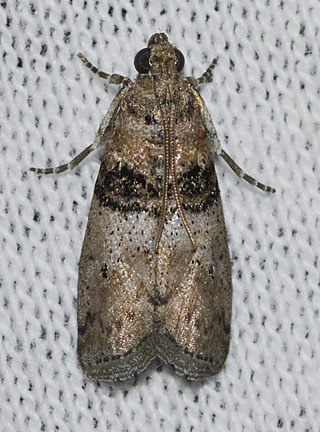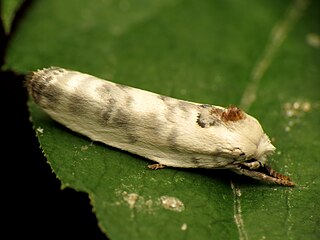
The tawny speckled pug is a moth of the family Geometridae.
Anatrachyntis rileyi, the pink cornworm, pink bud moth or pink scavenger, is a species of moth of the family Cosmopterigidae, the cosmet moths. It was first described by Lord Walsingham in 1882 from the southern United States, but it is probably an introduction to North America. It is found in much of the warm or tropical areas of the world, including northern Australia, the Galápagos Islands, Hawaii, the Antilles, South America and Mauritius.

Hellinsia inquinatus is a moth of the family Pterophoridae. It is found in North America, including Florida, Mississippi, Oklahoma, Tennessee, Maryland, Alabama, Texas, Missouri, Colorado and Arizona. It has also been recorded from Hispaniola, Mexico, Puerto Rico and St. Thomas Island.

Blastobasis glandulella is a species of moth of the family Blastobasidae. It is found in the Eastern United States and southern Ontario, Canada. It has also been recorded in California. In Europe, it has been recorded from Austria, Germany, the Czech Republic, Italy, Slovakia and Croatia.
Pyramidobela angelarum, The buddleia budworm moth, is a moth in the family Oecophoridae. It is known only from urban situations near the coast of California in the United States, but is most likely is introduced there, since the only known food plant is the ornamental Buddleia, which is a primarily tropical genus.
Holcocera iceryaeella is a moth in the family Blastobasidae. It is found in California, United States.
Sorhagenia baucidis is a moth in the family Cosmopterigidae. It was described by Ronald W. Hodges in 1969. It is found in North America, where it has been recorded from Illinois and Saskatchewan.

Acleris maculidorsana, the stained-back leafroller moth, is a species of moth of the family Tortricidae. It is found in North America, where it has been recorded from Arkansas, Florida, Georgia, Kentucky, Maine, Maryland, Massachusetts, Michigan, Mississippi, New Jersey, North Carolina, Ohio, Ontario, Pennsylvania, South Carolina, Tennessee, Virginia and Wisconsin.
Eudonia schwarzalis is a moth in the family Crambidae. It was described by Harrison Gray Dyar Jr. in 1906. It is found in North America, where it has been recorded from Arizona.

Eudonia spaldingalis is a moth in the family Crambidae. It was described by William Barnes and James Halliday McDunnough in 1912. It is found in North America, where it has been recorded from Alberta, Arizona, British Columbia, California, Colorado, Montana, Nevada, New Mexico, Utah and Wyoming.
Scoparia normalis is a moth in the family Crambidae. It was described by Harrison Gray Dyar Jr. in 1904. It has been recorded from the US states of Arizona, Colorado, New Mexico, North Carolina and Utah.

Tlascala is a monotypic snout moth genus described by George Duryea Hulst in 1890. Its only species is Tlascala reductella, the Tlascala moth, described by Francis Walker in 1863. It is found in North America, where it has been recorded from Florida to Illinois and Kentucky, as well as in Ontario. It has also been recorded from Honduras.

Agonopterix curvilineella, the curved-line agonopterix moth, is a species of moth in the family Depressariidae. It was first described by William Beutenmüller in 1889. It is found in North America, where it has been recorded from Illinois, Indiana, Kentucky, Maine, Maryland, Massachusetts, Michigan, Minnesota, Mississippi, New Brunswick, New York, Ohio, Ontario, Quebec, Tennessee, West Virginia and Wisconsin.

Eucosma abstemia is a species of moth of the family Tortricidae first described by Edward Meyrick in 1932. It is found in the United States, where it has been recorded from Colorado, Arizona and California.

Dichomeris punctidiscellus, the spotted dichomeris moth, is a moth in the family Gelechiidae. It was described by James Brackenridge Clemens in 1863. It is found in North America, where it has been recorded from southern Quebec, southern Ontario and Nebraska to Florida and south-eastern Texas.

Dichomeris costarufoella is a moth in the family Gelechiidae. It was described by Vactor Tousey Chambers in 1874. It is found in North America, where it has been recorded from Illinois and Louisiana to Nebraska, Oklahoma, Texas, New Mexico, Arkansas and Manitoba.
Gnorimoschema serratipalpella is a moth in the family Gelechiidae. It was described by Vactor Tousey Chambers in 1877. It is found in North America, where it has been recorded from Colorado and New Mexico.
Isophrictis pallidella is a moth of the family Gelechiidae. It was described by Vactor Tousey Chambers in 1874. It is found in North America, where it has been recorded from Colorado and Texas.
Glyphidocera lithodoxa is a moth in the family Autostichidae. It was described by Edward Meyrick in 1929. It is found in North America, where it has been recorded from Maine, Massachusetts, Ontario, Pennsylvania and Texas.

Antaeotricha leucillana, the pale gray bird-dropping moth, is a moth in the family Depressariidae. It was described by Philipp Christoph Zeller in 1854. It is found in North America, where it has been recorded from New Hampshire, Massachusetts, New York, Pennsylvania, District of Columbia, Virginia, North Carolina, Georgia, Alabama, Arkansas, Missouri, Kansas, Illinois, Iowa, Texas, Oregon, Louisiana, Manitoba and Nova Scotia.










